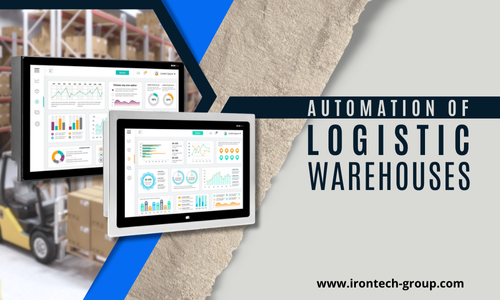The Role of Industrial Computers and Panel PCs in Warehouse and Logistics Automation
Warehouse automation has profoundly transformed the way companies manage their inventory and logistics processes. At the heart of this revolution are industrial computers and Panel PCs, robust and specialized devices that ensure the supervision, control, and efficient management of all aspects of warehouse automation. These computing systems are designed to operate in demanding industrial environments, where dust, vibrations, and extreme temperatures are common.
Thanks to their ability to manage large volumes of data in real-time, industrial computers enable automated warehouses to operate with pinpoint accuracy. Panel PCs, on the other hand, act as intuitive human interfaces for supervisors and operators, facilitating real-time monitoring and system adjustments. Together, these devices form the backbone of modern logistics automation, maximizing efficiency and minimizing human errors.
What is an Automated Warehouse?
An automated warehouse is a facility equipped with control systems and technological devices that allow the storage, retrieval, and distribution of goods automatically, minimizing human intervention. These warehouses are structured with automated management systems that integrate robots, transport systems, sensors, and specialized software. Industrial computers are essential to coordinate these activities, as they enable the processing of large amounts of information and communication between different devices, such as robots and conveyor belts.
The goal of an automated warehouse is to improve operational efficiency, reduce downtime, and optimize space usage. Unlike traditional warehouses, where tasks such as sorting, storage, and product retrieval are manual, an automated warehouse uses advanced technology to perform these activities faster and more accurately.
Benefits of an Automated Warehouse
The advantages of an automated warehouse are numerous, and each is directly linked to the use of advanced computing solutions and process automation. Some of the most notable benefits include:
- Greater efficiency and productivity: Automated systems allow 24/7 operations, leading to higher product handling capacity without interruptions.
- Error reduction: Thanks to the precision of computer systems and robots, errors in order preparation and shipping are significantly reduced.
- Space optimization: Automated storage systems, such as vertical warehouses, maximize the use of available space, storing more products in smaller areas.
- Lower operating costs: Reduced human intervention, along with optimized logistics processes, results in long-term lower operational costs.
- Increased safety: Automated systems reduce the need for workers to perform dangerous tasks, such as lifting heavy objects or working at heights.
How to Automate a Warehouse
Automating a warehouse involves implementing various technologies and control systems, coordinated through advanced management software. Below are the key steps to automate a warehouse:
- Needs assessment: A detailed analysis of product volume, workflow, and logistics requirements is conducted.
- Designing the automated system: The types of technologies that best fit the warehouse’s needs are selected. This includes mobile robots, transport systems, sensors, and automated vertical storage solutions.
- Implementation of industrial computers and management software: Industrial computers are installed to control and coordinate all automated equipment. Additionally, warehouse management software (WMS) is integrated to monitor inventory in real-time and manage operations.
- ERP integration: The warehouse automation system must be connected to the Enterprise Resource Planning (ERP) system, enabling data-driven decision-making.
- Training: Despite automation, it is essential that staff are trained to interact with the systems and understand how the Panel PCs and user interfaces operate.
Logistics Automation and Logistic Processes
Logistics automation involves optimizing the processes involved in receiving, storing, order preparation, and distribution of goods. This is achieved through the integration of advanced technologies that allow computing systems to manage these processes with minimal human intervention.
Key benefits of logistics process automation include shorter delivery times, more rigorous inventory control, and the ability to quickly adapt to demand changes. Industrial computers play a critical role in enabling various systems within the warehouse, such as picking robots and automated transport systems, to work in sync.
Automated Vertical Warehouses
Automated vertical warehouses represent an advanced solution within warehouse logistics automation, especially in facilities with space constraints. This type of warehouse utilizes the facility’s height to store products on multiple levels, maximizing the use of available space.
In automated vertical warehouses, products are stored on mobile shelves or modules that are managed by robotic systems controlled by industrial computers. These robots can efficiently retrieve and deliver products, minimizing access time and improving inventory management accuracy. Additionally, they provide quick and safe access to products without requiring workers to move around the warehouse.
In summary, warehouse automation, particularly through the adoption of automated vertical warehouses, not only improves operational efficiency but also enables better space and resource management, all driven by the integration of advanced computing technology and industrial computers.



